
Shopify is an all-in-one SaaS commerce platform designed to help businesses create, run, and manage online stores. It provides a hosted infrastructure with a drag-and-drop store builder, mobile-responsive themes, built-in checkout, and multi-channel integrations. Shopify enables users to manage products, process payments, and monitor sales within a unified admin dashboard.
The platform was founded in 2006 in Ottawa, Canada by Tobias Lütke, Daniel Weinand, and Scott Lake, initially as a solution to build their own online snowboard store, Snowdevil. Over time, Shopify evolved into a scalable solution for merchants across industries—powering over 4.8 million live websites globally as of 2025.
Shopify's core features include customizable theme templates, inventory and product management, built-in SEO settings, multi-currency and multi-language support, Shopify Payments, Shopify POS for in-person sales, and access to over 10,000 apps via the Shopify App Store. For developers, it supports headless architecture through Hydrogen (front-end toolkit built on React and Remix) and Oxygen (Shopify-managed hosting), with data powered by GraphQL APIs.
Pricing starts at $5/month (Starter plan) and scales to $2,000+/month (Shopify Plus) for enterprise users. Plans vary by feature access, staff accounts, transaction fees, and reporting capabilities. Each plan includes hosting, SSL certificates, and customer support.
Shopify supports front-end development through Liquid, React, and modern JS frameworks, and it maintains a growing developer ecosystem. With ongoing improvements like fully isolated instances (2025) and native B2B capabilities in Shopify Plus, the platform continues to serve both small businesses and large enterprises.
What is Shopify?
Shopify is an all-in-one commerce platform that enables individuals and businesses to build, launch, and manage eCommerce websites using a web-based interface. It is a SaaS (Software as a Service) platform that offers a drag-and-drop store builder, built-in hosting, and mobile-responsive design templates for desktop and mobile users. Shopify functions as a multi-channel commerce solution, allowing merchants to sell through their online store, social media platforms, marketplaces like Amazon, and in-person using Shopify POS. The platform eliminates the need for manual server setup, technical maintenance, or coding knowledge, making it accessible for non-technical users while remaining scalable for enterprise-level retailers.
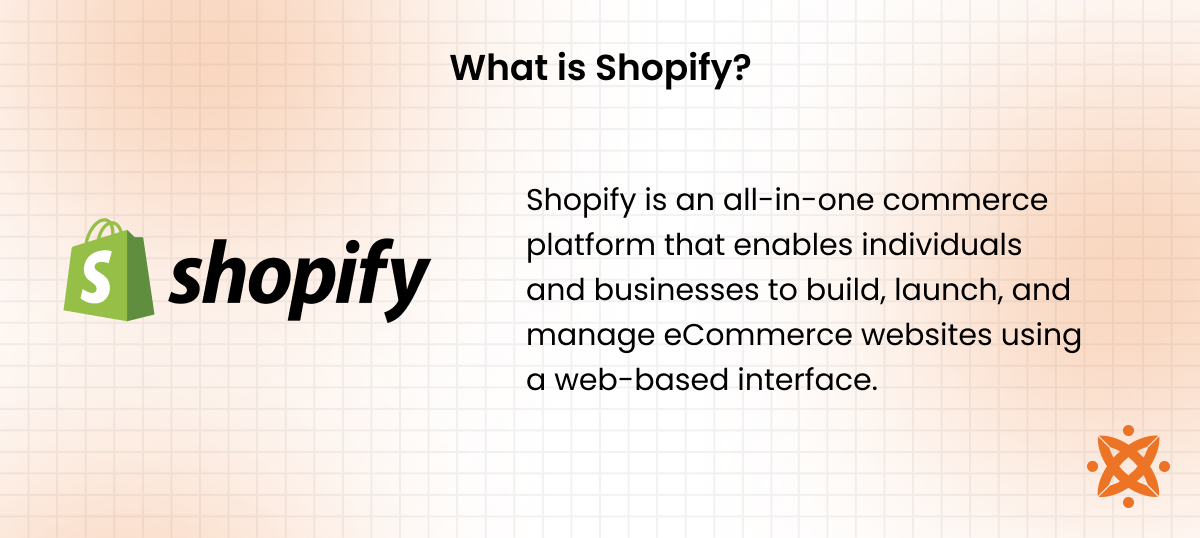
What is a Shopify Website?
A Shopify website is an eCommerce storefront built using the Shopify platform. It includes a storefront for product display, an admin panel for managing orders and inventory, a secure checkout system, and a Shopify-hosted domain or a connected custom domain. The outcome is a fully hosted online store that supports product management, customer engagement, and payment processing without requiring server configuration or backend development. Shopify websites benefit from integrated features such as mobile responsiveness, fast page loading, and automatic security updates.
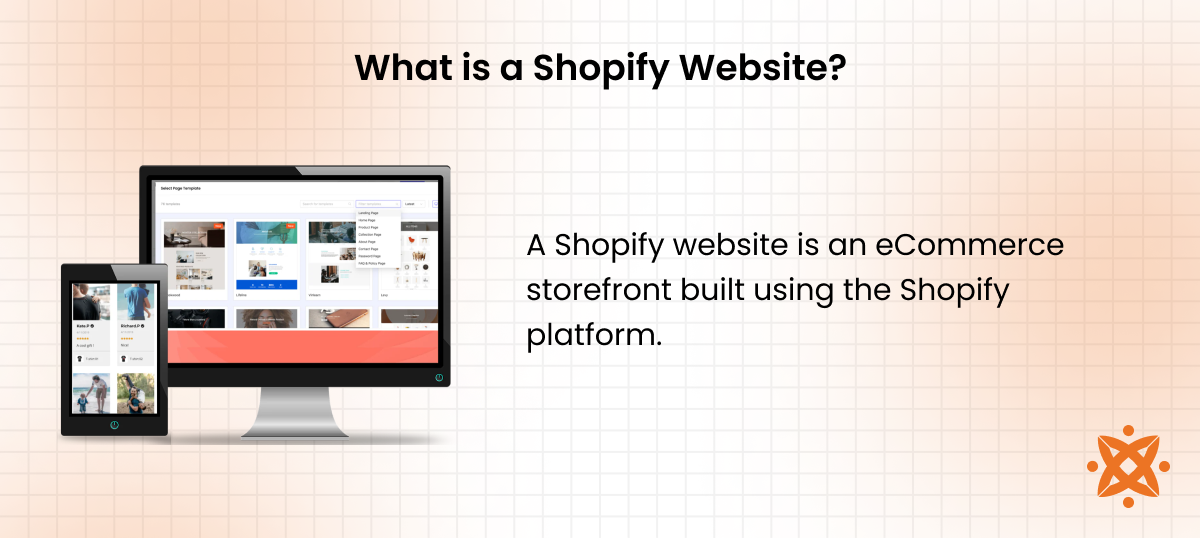
How Does Shopify Work?
Shopify works by providing a hosted SaaS platform that enables businesses to build and manage online stores without managing server infrastructure. The front-end uses customizable themes that define the storefront design. The admin interface allows product uploads, catalog organization, order tracking, and inventory updates. Integrated checkout systems support payment gateways such as Stripe and PayPal. Shopify includes built-in hosting, automatic SSL certificates, and global infrastructure that supports store scalability under high traffic.
What Are the Key Features of Shopify?
The key features of Shopify include tools and systems that support store design, product management, sales, and operations across online and offline channels:
- Theme Templates: Shopify provides customizable and mobile-responsive storefront themes that define the layout, typography, and visual identity of a Shopify website.
- Product and Inventory Management: Merchants can add product listings, manage SKUs, track inventory levels, and organize items into collections directly from the admin panel.
- Built-in SEO Tools: Shopify includes editable title tags, meta descriptions, and structured URLs to support on-page search engine optimization.
- Multi-Currency and Multi-Language Support: Shopify enables pricing in local currencies and provides translation options for storefronts to serve global customers.
- Shopify Payments: A native payment processing system that accepts major credit cards without relying on third-party gateways, with fraud analysis and chargeback handling.
- Shopify POS: A point-of-sale solution that connects in-store purchases to the same inventory and backend system as the online storefront.
- Shopify App Store: Access to over 8,000 third-party and Shopify-built apps for integrating marketing tools, CRM platforms, shipping providers, and analytics systems.
What Programming Language and Framework Is Shopify Built On?
Shopify was originally built with Ruby on Rails in 2004 and used a single-instance MySQL database for data storage. To improve scalability, Shopify later adopted database sharding. In 2021, Shopify introduced Hydrogen, a headless front-end framework using React and Remix for dynamic routing.
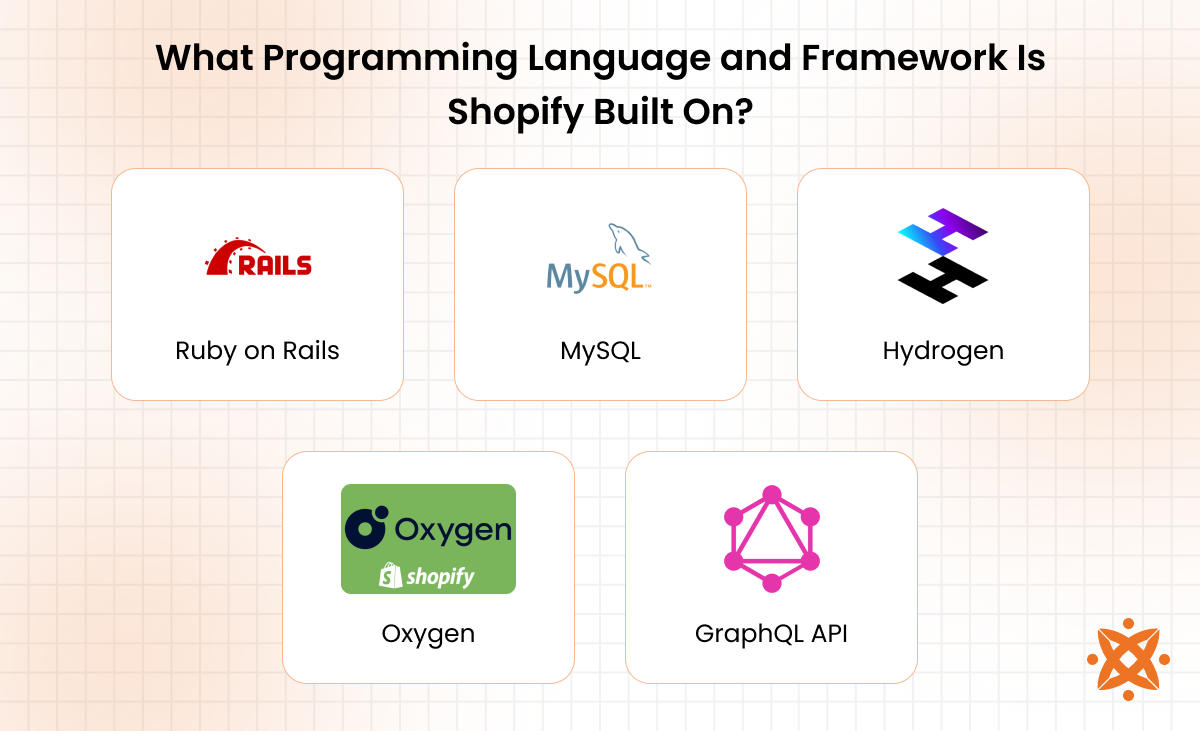
For deployment, Hydrogen apps run on Oxygen, Shopify's managed hosting platform. Shopify also transitioned to using GraphQL APIs to enable efficient data querying between front-end and back-end services.
The programming languages and frameworks used in Shopify's architecture include:
- Ruby on Rails – Used to build Shopify's core platform and back-end logic since 2004.
- MySQL (with Sharding) – Initially used as a single-instance database, later scaled using horizontal sharding techniques.
- React + Remix (Hydrogen) – Hydrogen is built using React and Remix to create customizable front-ends for headless commerce.
- Oxygen – A global hosting and deployment infrastructure managed by Shopify for running Hydrogen applications.
- GraphQL API – A structured query interface used to retrieve data from Shopify's back-end with improved speed and control.
What is Hydrogen and Oxygen in Shopify?
Hydrogen is Shopify's React-based headless framework introduced in 2021 for building custom storefronts. It uses React and Remix to offer full control over the front-end structure, enabling developers to build fast, interactive eCommerce experiences outside traditional Shopify themes.
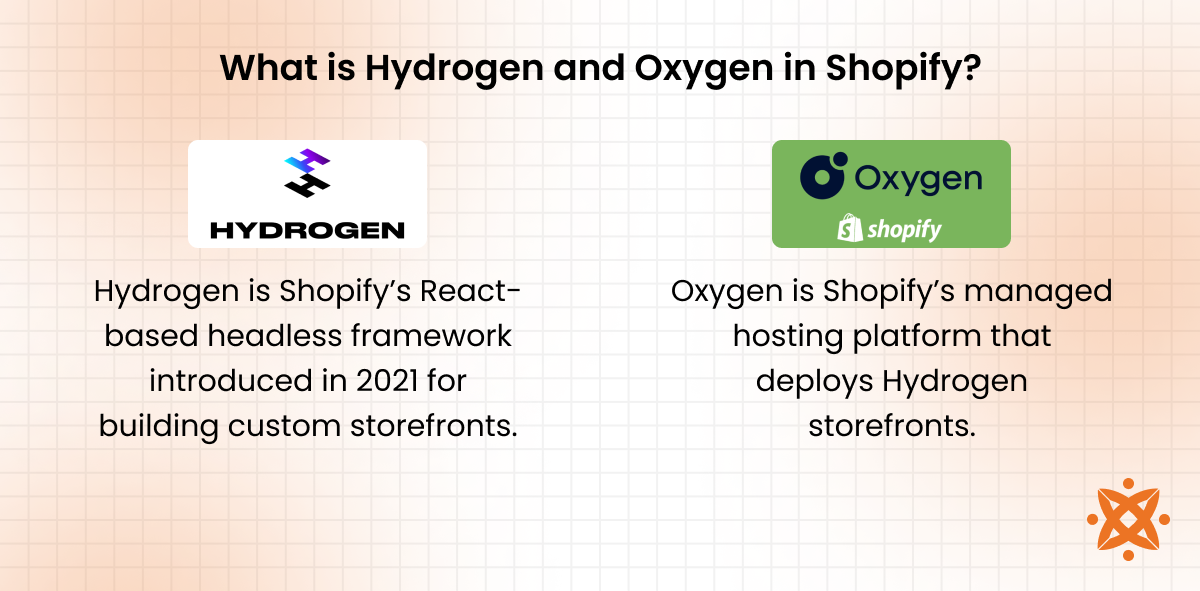
Oxygen is Shopify's managed hosting platform that deploys Hydrogen storefronts. It provides server-side rendering, routing, caching, and edge deployment optimized for Shopify's infrastructure. Together, Hydrogen and Oxygen support a decoupled architecture for scalable, high-performance commerce sites.
What Is the History of Shopify?
Shopify was founded in 2006 in Ottawa, Canada, by Tobias Lütke, who currently serves as the CEO. The platform originated from a 2004 project called Snowdevil, an online snowboard store built by Lütke to solve the limitations of existing eCommerce software.
Shopify remains a publicly traded company listed on the NYSE and TSX since its IPO in 2015. Tobias Lütke retains executive leadership, and the company is governed by its board of directors and shareholders.
Timeline of Shopify's Evolution:
2004: Tobias Lütke builds Snowdevil using Ruby on Rails.
2006: Shopify officially launches as a SaaS commerce platform.
2014: Shopify adopts sharding architecture to scale across multiple databases.
2015: Shopify completes its initial public offering (IPO).
2021: Hydrogen, a React-based headless framework, is introduced.
2025: Shopify transitions to fully isolated instances for app stability and performance.
How Much Does Shopify Cost?
Shopify offers multiple pricing plans to suit different business needs, ranging from entry-level to enterprise solutions. Each plan includes hosting, SSL certificates, and core eCommerce features, but varies in terms of transaction fees, staff accounts, reporting, and automation capabilities.
- Starter: $5/month. Enables selling via social and messaging apps. Includes a basic product page and checkout but no full storefront.
- Basic: $39/month. Includes a full online store, up to 1,000 inventory locations, 2 staff accounts, and 2.9% + 30¢ per transaction.
- Shopify: $105/month. Adds professional reports, 5 staff accounts, and lowers transaction fees to 2.6% + 30¢.
- Advanced: $399/month. Includes 15 staff accounts, advanced report builder, and third-party shipping rate calculations. Transaction fee is 2.4% + 30¢.
- Shopify Plus: Starts at $2,000/month. Designed for high-volume businesses and enterprises, includes multi-store support, Launchpad automation, and dedicated account management.
All plans offer Shopify Payments integration, but using external gateways incurs an additional 0.5%–2% fee, depending on the plan.
What Frontend Technologies Does Shopify Support?
Shopify supports multiple frontend technologies to enable custom storefront development using either native themes or headless architecture. Developers can build storefronts with Shopify's templating engine (Liquid) or use JavaScript frameworks via APIs for greater control and flexibility.
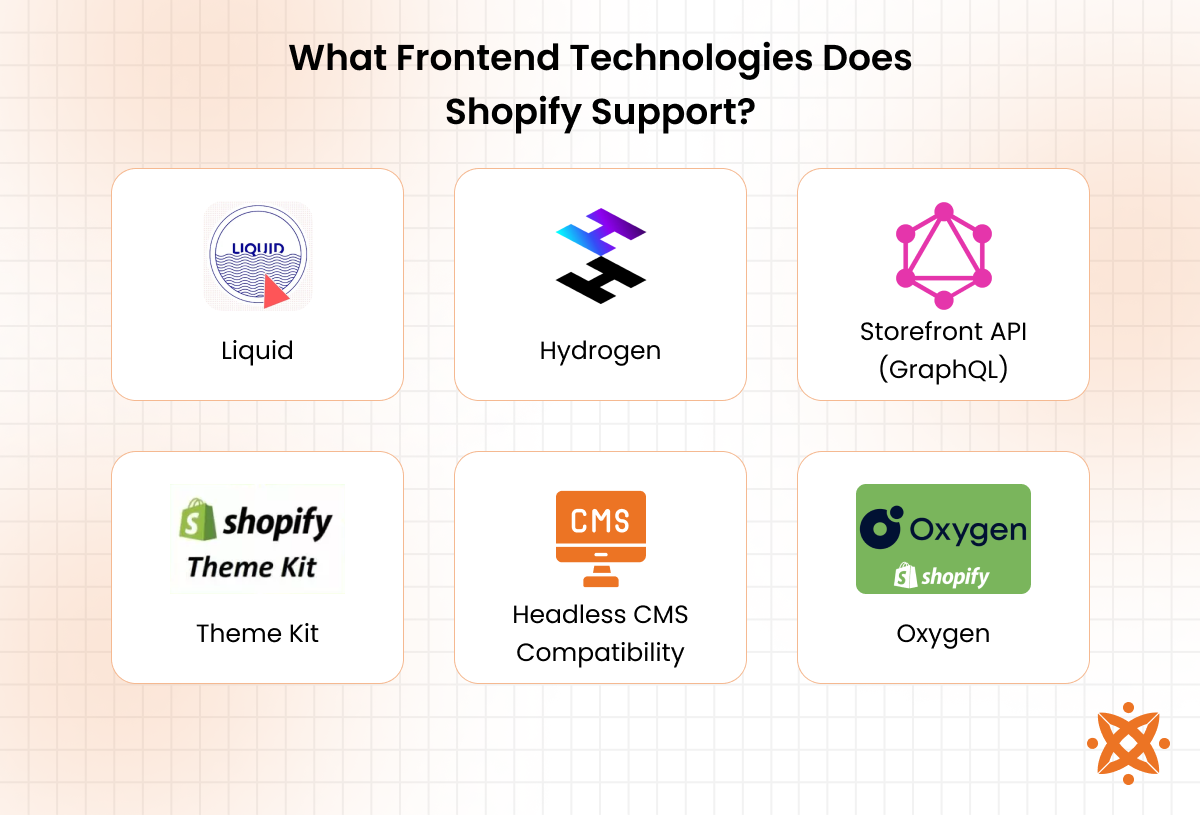
The key frontend technologies supported by Shopify include:
- Liquid: Shopify's proprietary templating language used in native themes to build store pages with server-rendered HTML and dynamic data binding.
- Hydrogen: A React-based framework released in 2021 that allows developers to build custom storefronts using React and Remix, optimized for performance and developer experience.
- Storefront API (GraphQL): Enables integration of any frontend stack (such as React, Next.js, Vue.js) by fetching product, cart, and checkout data for fully decoupled experiences.
- Theme Kit: A CLI tool used to develop and deploy themes built with Liquid, HTML, CSS, and JavaScript directly to Shopify stores.
- Headless CMS Compatibility: Shopify integrates with headless CMS platforms like Contentful or Sanity via APIs, enabling flexible content structures in frontend frameworks.
- Oxygen: Shopify's hosting layer for deploying Hydrogen storefronts with built-in server-side rendering and edge network performance.
All technologies align with Shopify's architecture for scalable, fast-loading, and customizable eCommerce storefronts.
What is Shopify Plus?
Shopify Plus is the enterprise version of Shopify, designed for high-volume stores and B2B commerce. It extends core Shopify functionality with backend access, automation tools, and dedicated infrastructure. It supports advanced APIs for ERP, CRM, and PIM integration. Its B2B features include wholesale account management, company profiles, and custom pricing rules.
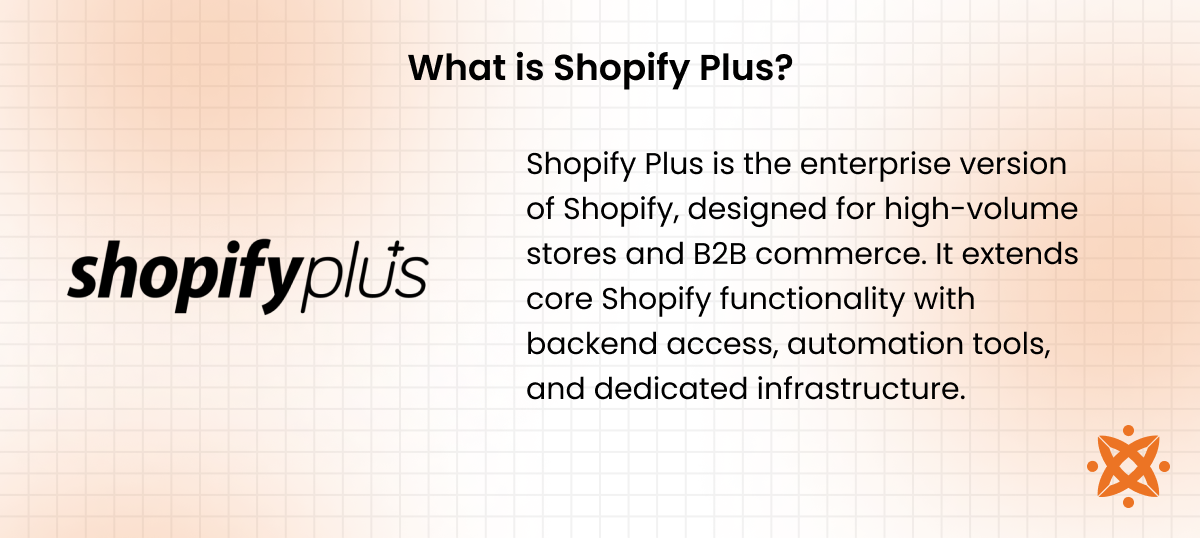
The platform offers dedicated support with launch engineers and 24/7 priority assistance. It enables multi-storefront management from a single dashboard with currency, language, and region controls. Custom checkout scripts allow businesses to configure shipping, discounts, and payment conditions. Shopify Flow automates workflows through triggers and logic-based actions. Shopify Plus is used by brands needing system-level access, process automation, and control across markets.
What is the difference between Shopify and Shopify Plus?
The main differences between Shopify and Shopify Plus are based on pricing, API access, storefront control, support, and B2B capabilities.
- Pricing: Shopify plans range from $39 to $399/month, while Shopify Plus starts at $2,000/month or based on revenue share for large-scale businesses.
- API Access: Shopify Plus includes expanded API limits for Admin, Storefront, and Checkout APIs, enabling deeper third-party integrations.
- Storefront Flexibility: Shopify Plus users gain access to advanced checkout customisation with Script Editor and support for multiple storefronts.
- Support: Shopify offers general support via chat and email; Plus users receive dedicated launch engineers and priority support.
- B2B Features: Shopify Plus includes native B2B functionality such as customer-specific pricing, payment terms, and multi-location ordering.
These differences position Shopify Plus for enterprises managing multiple brands, high order volumes, or wholesale operations, while standard Shopify fits small to mid-sized businesses.
What Types of Businesses Use Shopify?
Shopify is used by a wide range of business models due to its scalability, app ecosystem, and ease of use.
- Direct-to-Consumer (DTC) Brands: Brands like Allbirds use Shopify to manage inventory, process high order volumes, and support mobile-first shopping experiences.
- Subscription Box Services: Businesses offering recurring product deliveries integrate Shopify with tools like Recharge to handle subscription billing and logistics.
- Fashion and Apparel Stores: Fashion retailers use Shopify for product variation handling, lookbook-style themes, and social commerce integrations.
- Digital Product Sellers: Creators selling eBooks, courses, or software use Shopify to deliver files securely and manage licensing.
- Dropshipping Businesses: Entrepreneurs use Shopify with Oberlo, Spocket, or DSers to automate supplier sync, order forwarding, and margin tracking.
Shopify suits these sectors by offering multi-channel selling, extensibility via apps, and infrastructure to support rapid growth.
What Are the Pros and Cons of Shopify?
Shopify provides a managed eCommerce solution with essential tools for online selling. The platform simplifies setup and operations for businesses across various sectors but comes with trade-offs in customization and cost.
The key advantages of Shopify include:
- Hosted SaaS Platform: No need for manual server management, hosting, or updates.
- Extensive App Ecosystem: Access to over 8,000 apps for marketing, shipping, analytics, and more.
- Multi-Channel Selling: Integration with Facebook, Instagram, Amazon, and other marketplaces.
- Mobile-Responsive Themes: Optimized templates for smartphones and tablets.
- Built-in Security: SSL certificate, PCI compliance, and automatic backups included.
- Fast Store Deployment: Businesses can launch a store within days without advanced coding.
The main limitations of Shopify include:
- Monthly Subscription Fees: Ranges from $39 to $399, plus additional costs for premium apps.
- Transaction Fees: Shopify charges 0.5%–2.0% if not using Shopify Payments.
- Limited Backend Flexibility: Developers must work within Shopify's Liquid templating engine.
- Dependency on Apps: Custom features often require third-party plugins, increasing cost and maintenance.
- Content Management Constraints: Shopify's CMS is less robust for blog-heavy websites compared to WordPress.
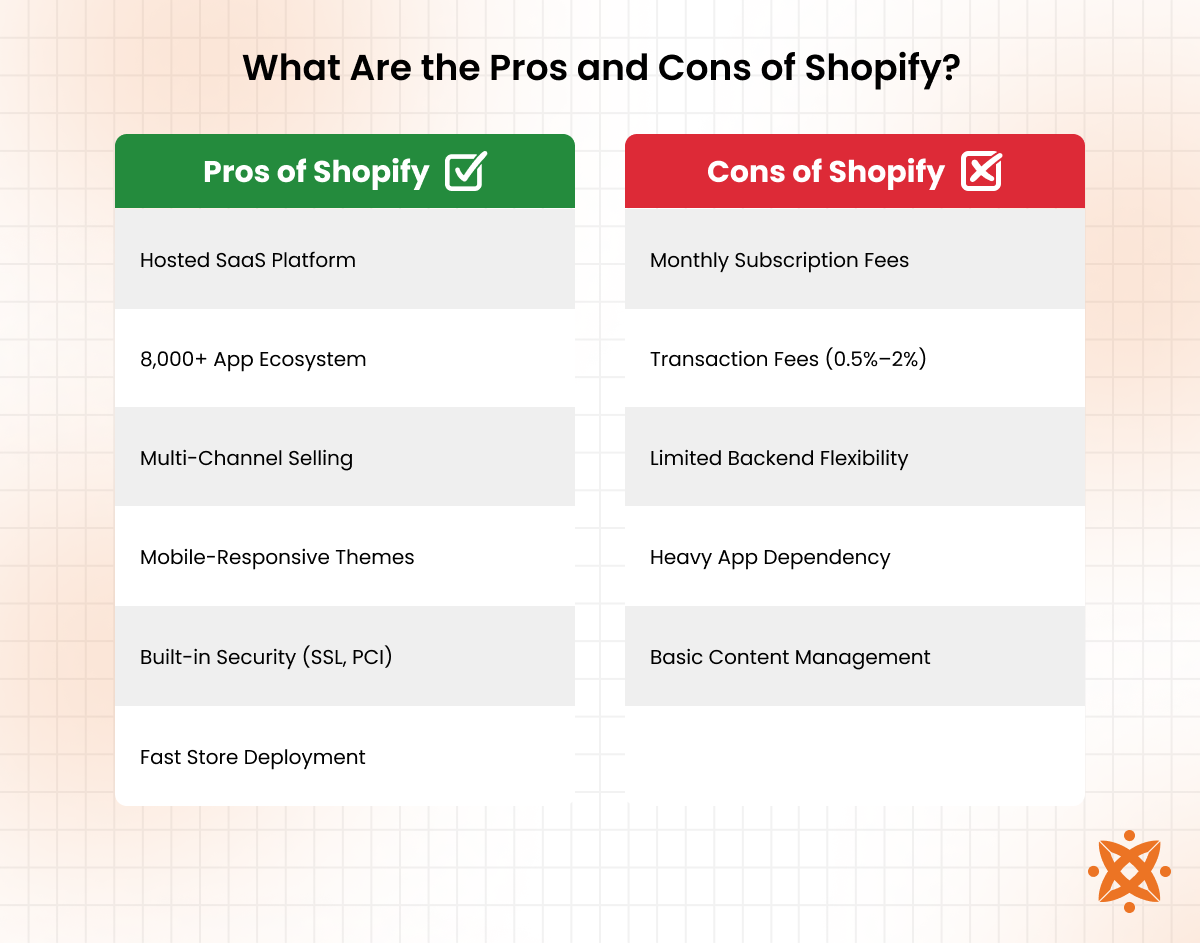
How Does Shopify Compare to Woocommerce or Wix?
The following table compares Shopify, WooCommerce, and Wix across key decision-making criteria: hosting model, usability, customization level, cost structure, plugin ecosystem, and SEO flexibility.
| Attribute | Shopify | WooCommerce | Wix |
| Hosting | Fully hosted SaaS platform | Self-hosted (requires separate hosting) | Fully hosted website builder |
| Ease of Use | User-friendly with guided setup | Requires WordPress setup and plugin handling | Drag-and-drop interface, limited flexibility |
| Customization | Moderate (theme-based + apps) | High (full code access via WordPress) | Limited compared to Shopify or WooCommerce |
| Cost | Starts at $39/month + transaction fees | Free plugin, but hosting and extensions add cost | Starts at $17/month, add-ons extra |
| Plugins | 8,000+ apps via Shopify App Store | 60,000+ plugins via WordPress | Fewer apps, limited third-party support |
| SEO | Built-in SEO with clean URLs, app extensions | Full SEO control via WordPress plugins | Basic SEO with limited control |
Shopify offers the most balanced option for businesses seeking ease, scalability, and support. WooCommerce delivers high flexibility and control for users with technical skills. Wix is suited for basic online stores or personal projects that prioritize simplicity over extensibility.
What is the Shopify App Store?
The Shopify App Store is an official extension marketplace that provides access to over 8,000 applications designed to expand the core functionality of Shopify websites. It allows merchants to enhance their storefronts without custom development by installing apps directly through the admin interface.
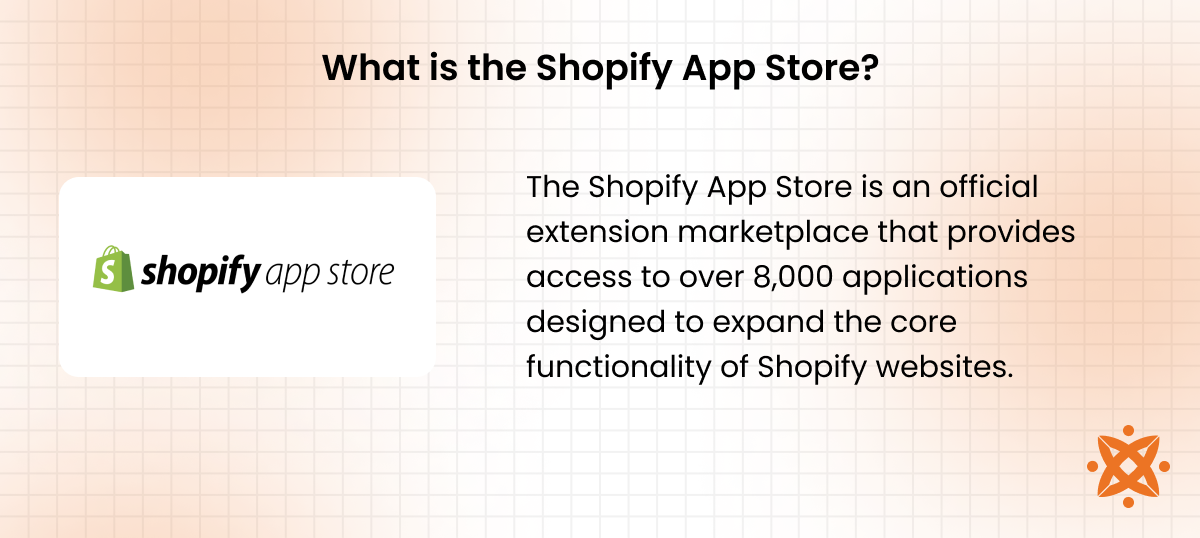
Available app categories include marketing tools for email automation, social media integration, and retargeting; inventory management solutions for stock syncing, SKU tracking, and forecasting; product review tools for gathering and displaying customer feedback; payment gateway integrations for local and international providers; and shipping and fulfilment apps offering real-time rates, tracking, and logistics automation. These extensions address specific operational needs and enable scalable business workflows within the Shopify ecosystem.
How Many Apps Are in the Shopify App Store?
The Shopify App Store currently features over 10,000 apps, providing merchants with an extensive range of extensions to add functionality to their Shopify websites.
These apps fall into key categories essential for online retail operations:
- Marketing Automation – tools for email campaigns, SEO, and retargeting
- Inventory Management – real-time stock sync and SKU tracking
- Customer Reviews – collection and display systems
- Payment Gateways – integrations with providers like Stripe or PayPal
- Shipping and Fulfillment – live shipping rates and tracking features
What is Headless Shopify?
Headless Shopify refers to a decoupled eCommerce architecture where the front-end presentation layer is separated from the back-end commerce engine. This structure allows developers to use custom front-end frameworks while still managing products, orders, and checkout through Shopify's back end.
Shopify enables headless commerce through Hydrogen, its React-based front-end toolkit, and GraphQL Admin and Storefront APIs, which allow real-time data exchange between the custom interface and Shopify's infrastructure. This approach supports personalized user experiences, faster page loads, and integration with modern web development stacks.
What Is the Difference Between Shopify and Headless Shopify?
The differences between Shopify and Headless Shopify are based on architecture, design flexibility, API usage, and development approach. Shopify follows a monolithic model where the front-end and back-end are coupled, using built-in themes powered by Liquid templating. It is designed for simplicity, making it suitable for small to medium businesses that need quick deployment with manageable customization.
In contrast, Headless Shopify separates the front-end from the back-end. Developers can build custom storefronts using modern frameworks like React, Vue, or Next.js, while the back-end is managed by Shopify. This setup relies on GraphQL APIs for dynamic data delivery and allows full control over user interface, performance, and content presentation. While Headless Shopify increases development complexity, it enables advanced use cases such as multi-channel selling, progressive web apps, and custom UX for enterprises or high-growth brands.
Never Miss an Update From Us!
Sign up now and get notified when we publish a new article!
Dhaval Sarvaiya
Co-Founder
Hey there. I am Dhaval Sarvaiya, one of the Founders of Intelivita. Intelivita is a mobile app development company that helps companies achieve the goal of Digital Transformation. I help Enterprises and Startups overcome their Digital Transformation and mobile app development challenges with the might of on-demand solutions powered by cutting-edge technology.
